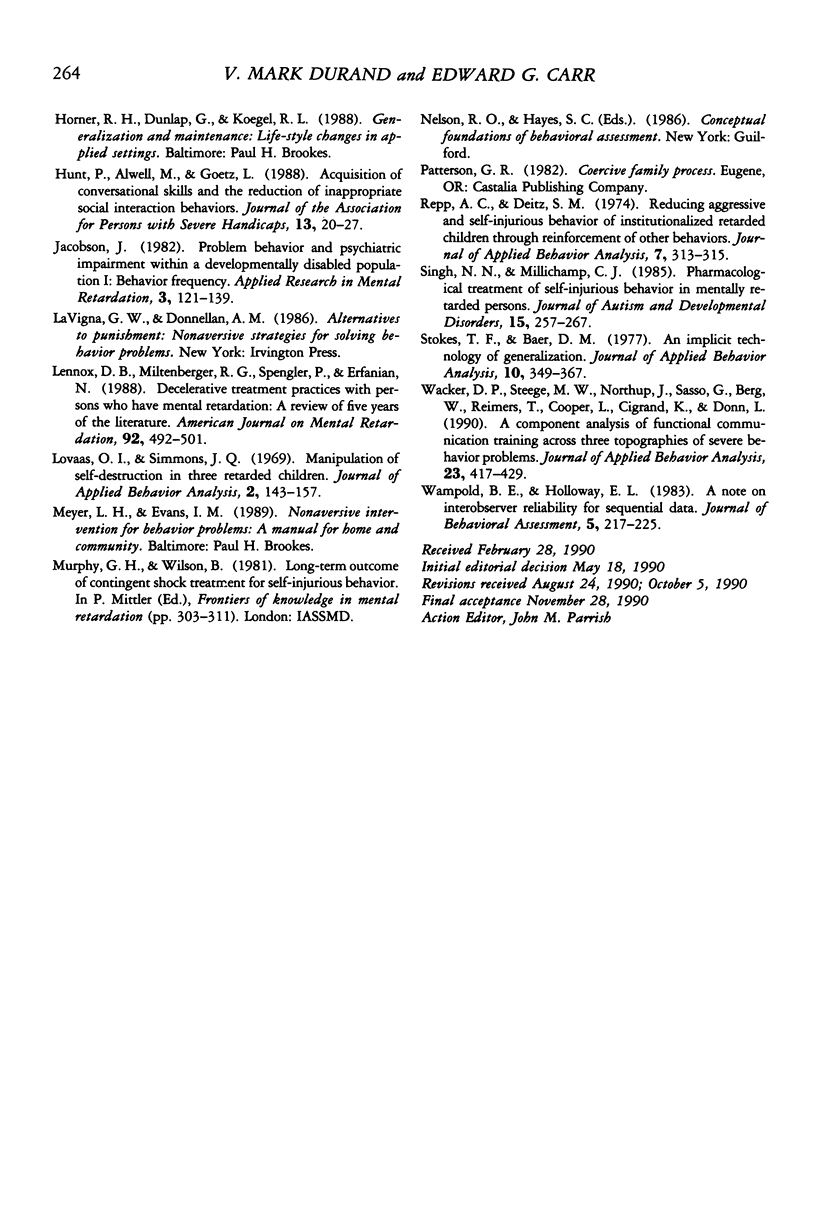Abstract
We evaluated the initial effectiveness, maintenance, and transferability of the results of functional communication training as an intervention for the challenging behaviors exhibited by 3 students. Assessment indicated that escape from academic demands was involved in the maintenance of the challenging behaviors. Social attention was also implicated as controlling the behavior of 1 student. The intervention involved teaching alternative assistance-seeking and attention-getting phrases to the students in an effort to replace challenging behavior with these verbal equivalents. Multiple baseline data collected across the 3 students indicated that not only did the intervention substantially reduce challenging behavior but also that these results transferred across new tasks, environments, and teachers, and were generally maintained from 18 to 24 months following the introduction of functional communication training. These results are discussed in light of recent efforts to develop effective interventions for severe challenging behavior and to understand the processes underlying transfer and maintenance of intervention effects.
Full text
PDF













Selected References
These references are in PubMed. This may not be the complete list of references from this article.
- Bird F., Dores P. A., Moniz D., Robinson J. Reducing severe aggressive and self-injurious behaviors with functional communication training. Am J Ment Retard. 1989 Jul;94(1):37–48. [PubMed] [Google Scholar]
- Carr E. G., Durand V. M. Reducing behavior problems through functional communication training. J Appl Behav Anal. 1985 Summer;18(2):111–126. doi: 10.1901/jaba.1985.18-111. [DOI] [PMC free article] [PubMed] [Google Scholar]
- Carr E. G., Kemp D. C. Functional equivalence of autistic leading and communicative pointing: analysis and treatment. J Autism Dev Disord. 1989 Dec;19(4):561–578. doi: 10.1007/BF02212858. [DOI] [PubMed] [Google Scholar]
- Durand V. M., Carr E. G. Social influences on "self-stimulatory" behavior: analysis and treatment application. J Appl Behav Anal. 1987 Summer;20(2):119–132. doi: 10.1901/jaba.1987.20-119. [DOI] [PMC free article] [PubMed] [Google Scholar]
- Durand V. M., Crimmins D. B. Assessment and treatment of psychotic speech in an autistic child. J Autism Dev Disord. 1987 Mar;17(1):17–28. doi: 10.1007/BF01487257. [DOI] [PubMed] [Google Scholar]
- Durand V. M., Crimmins D. B. Identifying the variables maintaining self-injurious behavior. J Autism Dev Disord. 1988 Mar;18(1):99–117. doi: 10.1007/BF02211821. [DOI] [PubMed] [Google Scholar]
- Eyman R. K., Borthwick S. A. Patterns of care for mentally retarded persons. Ment Retard. 1980 Apr;18(2):63–66. [PubMed] [Google Scholar]
- Eyman R. K., Call T. Maladaptive behavior and community placement of mentally retarded persons. Am J Ment Defic. 1977 Sep;82(2):137–144. [PubMed] [Google Scholar]
- Halle J. W., Baer D. M., Spradlin J. E. Teachers' generalized use of delay as a stimulus control procedure to increase language use in handicapped children. J Appl Behav Anal. 1981 Winter;14(4):389–409. doi: 10.1901/jaba.1981.14-389. [DOI] [PMC free article] [PubMed] [Google Scholar]
- Harris S. L., Ersner-Hershfield R. Behavioral suppression of seriously disruptive behavior in psychotic and retarded patients: a review of punishment and its alternatives. Psychol Bull. 1978 Nov;85(6):1352–1375. [PubMed] [Google Scholar]
- Jacobson J. W. Problem behavior and psychiatric impairment within a developmentally disabled population I: behavior frequency. Appl Res Ment Retard. 1982;3(2):121–139. doi: 10.1016/0270-3092(82)90002-9. [DOI] [PubMed] [Google Scholar]
- Lennox D. B., Miltenberger R. G., Spengler P., Erfanian N. Decelerative treatment practices with persons who have mental retardation: a review of five years of the literature. Am J Ment Retard. 1988 May;92(6):492–501. [PubMed] [Google Scholar]
- Lovaas O. I., Simmons J. Q. Manipulation of self-destruction in three retarded children. J Appl Behav Anal. 1969 Fall;2(3):143–157. doi: 10.1901/jaba.1969.2-143. [DOI] [PMC free article] [PubMed] [Google Scholar]
- Repp A. C., Deitz S. M. Reducing aggressive and self-injurious behavior of institutionalized retarded children through reinforcement of other behaviors. J Appl Behav Anal. 1974 Summer;7(2):313–325. doi: 10.1901/jaba.1974.7-313. [DOI] [PMC free article] [PubMed] [Google Scholar]
- Singh N. N., Millichamp C. J. Pharmacological treatment of self-injurious behavior in mentally retarded persons. J Autism Dev Disord. 1985 Sep;15(3):257–267. doi: 10.1007/BF01531497. [DOI] [PubMed] [Google Scholar]
- Stokes T. F., Baer D. M. An implicit technology of generalization. J Appl Behav Anal. 1977 Summer;10(2):349–367. doi: 10.1901/jaba.1977.10-349. [DOI] [PMC free article] [PubMed] [Google Scholar]
- Wacker D. P., Steege M. W., Northup J., Sasso G., Berg W., Reimers T., Cooper L., Cigrand K., Donn L. A component analysis of functional communication training across three topographies of severe behavior problems. J Appl Behav Anal. 1990 Winter;23(4):417–429. doi: 10.1901/jaba.1990.23-417. [DOI] [PMC free article] [PubMed] [Google Scholar]


